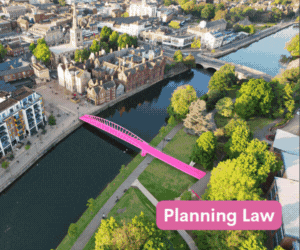Countryside charity loses legal challenge against planning permission for 165 homes at site in Area of Outstanding Natural Beauty
The Campaign for the Protection of Rural England’s (CPRE) Kent Branch has failed in a challenge to a planning inspector’s decision that 165 homes can be built at Cranbrook.
- Details
It brought the case under section 288 of the Town and Country Planning Act 1990 against the Secretary of State for Housing, Communities and Local Government, Tunbridge Wells Borough Council and developer Berkeley Homes (Eastern Counties).
Mr Justice Mould heard in the High Court that Berkeley had applied for planning permission from Tunbridge Wells but before this could be decided in April 2021, the then Secretary of State called in the planning application under section 77 of the 1990 Act.
Following an inquiry the inspector recommended planning permission should be granted subject to conditions, which the Secretary of State initially refused leading to litigation by Berkeley and in October 2023, that determination was quashed by order of the court giving Berkeley permission.
Mould J noted the site is within the High Weald Area of Outstanding Natural Beauty (AONB) and that Section 85(A1) of the Countryside Act 2000 imposes a general duty on relevant authorities to seek to “further the purpose of conserving and enhancing the natural beauty of the area of outstanding natural beauty”.
The CPRE argued that by granting permission for a development which will neither conserve nor enhance the natural landscape - but rather result in harm to it - the Secretary of State failed to perform the duty under section 85(A1) of the 2000 Act.
Its first ground of challenge was that the only decision lawfully open to the Secretary of State was to refuse planning permission as to grant permission for a development that would harm natural beauty was not capable in law of discharging the duty under section 85(A1).
The CPRE’s second ground was that the Secretary of State failed to give proper, adequate and intelligible reasons for concluding the duty was complied with.
Mould J directed the case should be heard together with one brought by Wadhurst Parish Council, which raised similar issues.
On Ground 1, the CPRE submitted that a relevant authority must both exercise its functions consistently with the purpose of conserving and enhancing the natural beauty of the protected landscape and achieve that purpose so far as possible.
It argued that the duty cannot be interpreted as enabling a relevant authority to allow harm.
For Ground 2, the CPRE said it was insufficient for the Secretary of State “merely to mention that statutory duty or to assert that it had been complied with”.
CPRE said that on a fair reading of the decision letter, the Secretary of State failed to grapple with the fact that the proposed development conflicted with the statutory purpose of conserving and enhancing the natural beauty of the AONB and gave no adequate explanation of how this conflict was resolved.
But Mould J found himself “satisfied the [Secretary of State] fulfilled her duty to give proper, intelligible and adequate reasons in this case.
“The claimant's contention that her reasoning is inadequate and gives rise to a substantial doubt that she has indeed properly complied with the duty imposed by section 85(A1) of the 2000 Act is not justified.”
He said matters should be expressed in terms of weight, and the section 85(A1) duty did not - and was not intended to - “displace the established evaluative character of the determination of planning applications, which arises from the long-established principles that govern such decisions under sections 70 of the 1990 Act and 38(6) of the 2004 Act”.
Mould J said the Secretary of State’s reasoning showed the site and its proposed development for housing had been identified through a process of plan making, with a compelling case to meet local needs with only limited harm to the AONB.
There were no identified alternative sites either within or outside the AONB which would deliver the housing needed with a lesser impact.
Ground 2 concerning the adequacy of reasons failed because the Secretary of State had given a “proper and adequate reasons to explain why that was so” that the law does not rule out grants of planning permission in an AONB.
Mark Smulian
Trust Solicitor (Employment & Contract Law)
Lawyer - Property
Contracts & Procurement Lawyer
Senior Lawyer - Contracts & Commercial
Locums
Poll









































